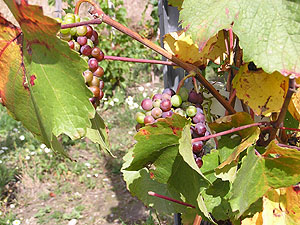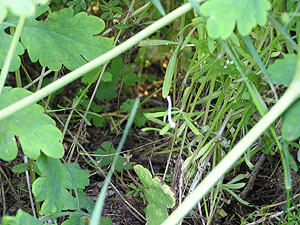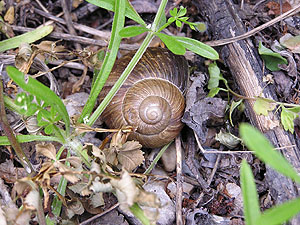
"Vineyard snails" today only rarely are found in vineyards.
There are, though, many other biotopes on soil rich in lime,
where Roman snails thrive. [CK]
Though called "vineyard snail" in many languages, Roman snails today only rarely appear in vineyards or in other agriculturally used areas. Those areas often have been treated heavily with chemical herbicides or insecticides, besides, the soil usually is saturated with fertiliser to an extent that renders it uninhabitable for snails.
 "Vineyard snails" today only rarely are found in vineyards. There are, though, many other biotopes on soil rich in lime, where Roman snails thrive. [CK] |
The natural landscape today is formed and influenced by man. This offers a Roman snail the choice of many other suitable living spaces. Today, it is even assumed, that the species Helix pomatia only was able to settle in Europe north of the Alps as a consequence to man made environment. Because of human postglacial settlements Central European primeval forests were replaced by bush and hedge biotopes that the Roman snail needs as habitats.
Basically Roman Snails may be found in bushes, groves next to fields, paths and streets, also in overgrown gardens, cemeteries and parks, as well as in the fringes of deciduous and mixed forests. It is only with rarity that Roman snails occur in the deep of the forest, and then only in deciduous and mixed forests. In coniferous forests there usually neither is food in sufficient supply, nor is the mostly acid soil suitable for Roman snails, more accustomed to alkaline soils based on limestone.
Certain environmental factors limit the natural distribution of Roman snails:
 On limestone soils there usually is a thick vegetation cover providing Roman snails with protection as well as food. [CK] |
Sufficient food for Roman snails there is almost everywhere in Central Europe. But a supply of lime sufficient to satisfy the needs of Roman snails strongly limits their distribution to soils formed by the decomposition of limestone. Provided there is sufficient regular precipitation, those soils also carry a vegetation cover suitable not only as food but also as a hiding place from predators and from the desiccating effect of sunlight and wind.
Soils develop by the decomposition of the stone below them, caused by the long-term effect of precipitation, sun and wind. Their properties are mainly influenced by the chemical character they develop from. Best suitable for Roman snails, like for most terrestrial snails, are limestone-based soils, such as they can be found in many humid low mountain ranges. They are good in storing heat and because of their origin they are very rich in lime, their pH-value is alkaline. That also means, they are very rich in nutrients, so provided sufficient precipitation there will be a rich vegetation cover.
Similarly suitable are also moderate clay soils and humid grounds, provided they are not too acid. Sandy and boggy soils, which are poor in nutrients, as well as the acid humus soils of coniferous forests, are usually avoided by Roman snails.
 A Roman snail's activity essentially depends on temperature and humidity. [RN] |
A Roman snail's activity, as well as possibly its survival, essentially depends on temperature and humidity (See also: Senses of Temperature and Humidity). The temperature for optimal living conditions to a Roman Snail ranges from 12 to 25 °C. Below 8 °C the Roman snail will begin to prepare for hibernation, over 25 °C it will become inactive and fall into aestivation. Particularly problematic are unexpected freezing temperatures in early spring. Triggered by the early warmth, the snails wake from hibernation and are not able any more to protect themselves from the sudden frost. That way whole populations of snails can freeze to death in spring.
A Roman snail, like most terrestrial snails, is a moist air animal, for which humidity constitutes a vital factor. Dew, light rain or a relative humidity (actual humidity in relation to the maximal humidity at the given temperature) of more 50% have a vitalising effect on snails – they crawl around and feed particularly much. In summer those conditions can almost only be found in the early morning and in the evening.
So depending on the time of day the snails behave differently.